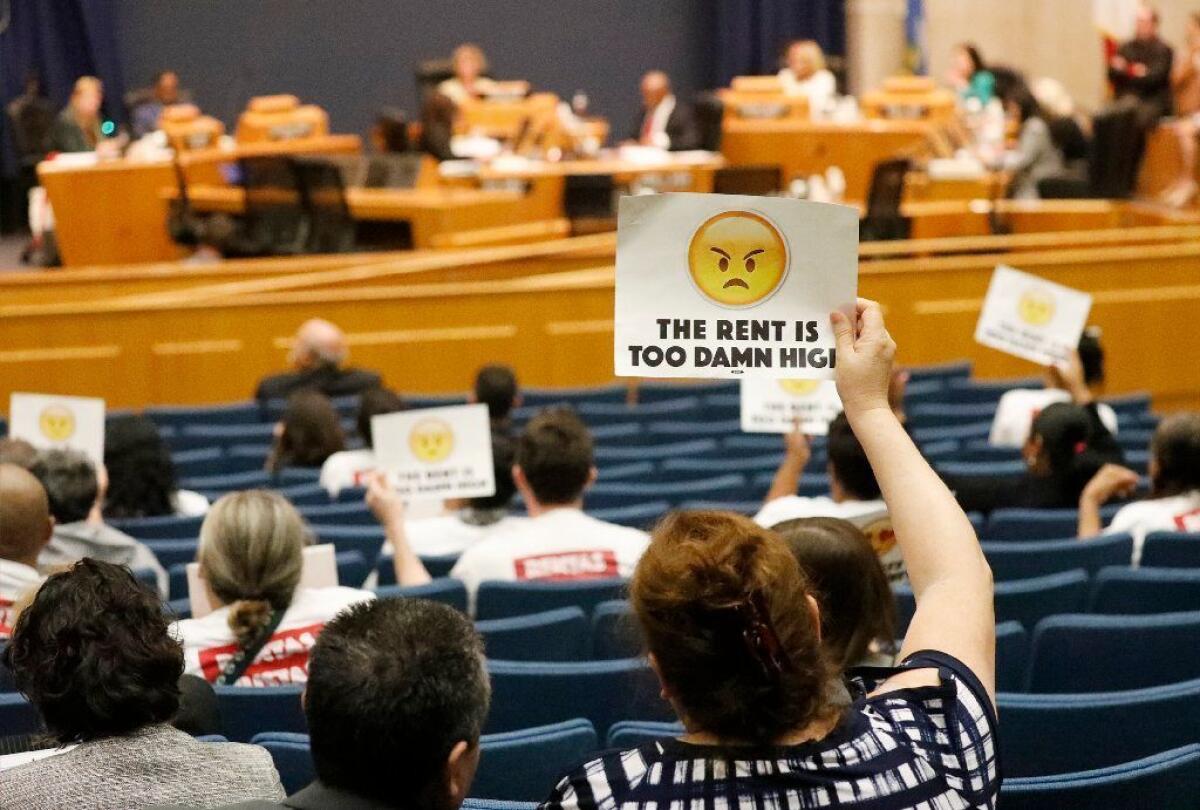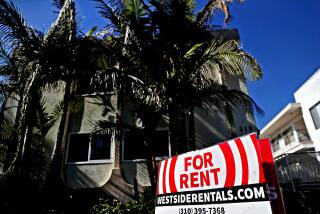California will limit rent increases under bill signed by Gov. Gavin Newsom

OAKLAND — Californians will for the first time have new safeguards against large rent increases after Gov. Gavin Newsom signed legislation on Tuesday capping annual rent hikes for the next decade. The new protections come as high rents burden nearly 10 million tenants in California and major metropolitan regions have seen double-digit increases in their homeless populations.
The governor hailed Assembly Bill 1482 as the nation’s strongest statewide renter protection measure, saying that tenants deserved relief from the state’s soaring housing costs, which have threatened the ability to stay in their homes.
“This is a profoundly important moment,” Newsom said while surrounded by lawmakers and tenant advocates at a signing ceremony in Oakland. “The fact that we are leading the nation in trying to meet this moment is a point of pride.”
Under the new law, most yearly rent increases over the next decade will be limited to 5% plus inflation and tenants will receive protections against being evicted without cause. Had the rent cap been in place this year, rent increases in the Los Angeles area would be limited to 8.3% while those in San Francisco would have been capped at 9%.
California is the third state to have passed a significant expansion of renter protections this year. Oregon approved a statewide rent cap of 7% a year plus inflation, but unlike California, its law won’t expire in 10 years. New York legislators boosted existing rent controls in New York City and allowed other communities in the state to implement the policy.
The law’s signing also comes less than a year after California voters decisively rejected a ballot initiative that would have allowed cities and counties to impose stricter rent controls in their communities. Newsom, who opposed that initiative, subsequently called on lawmakers to pass measures that would provide some stability for tenants, leading to Tuesday’s action.
Some 9.5 million renters — more than half of California’s tenant population — are burdened by high rents, spending at least 30% of their income on housing costs, according to a recent estimate by UC Berkeley’s Haas Institute for a Fair and Inclusive Society. And many other Californians are feeling the effects of the housing crisis. A recent poll by the nonpartisan Public Policy Institute of California found that 15% of adult residents cited homelessness as the state’s most pressing issue, tied for first with the economy. Eleven percent of adults in the same poll said housing costs and availability was the top problem.
There are a number of exceptions to the law’s new rules. The rent cap will not apply to apartments built within the last 15 years or single-family home rentals unless they’re owned by corporations or other institutional investors.
Limits on rent increases will not change for those currently living in rent-controlled apartments. But the new rules extend protections for renters living in newer complexes in cities with rent control. In Los Angeles, for instance, rent control limits increases to about 3% or 4% per year for those living in apartments built before October 1978. Tenants in buildings constructed between that time and 2005 will see any increases to their rent capped under the new law.
The law, which will take effect on Jan. 1, also prohibits landlords from evicting tenants who have lived in an apartment for a year without proof of documented lease violations.
About 2.4 million California households will be affected by the new rent cap in addition to those who live in single-family home rentals that meet the law’s requirements, according to an estimate by UC Berkeley’s Terner Center for Housing Innovation.
While the new law allows for rent increases that are much higher than average wage growth, renter advocates argue it will prevent sudden surges at levels that could drive people from their homes. An analysis of rental listing data by real estate website Zillow found about 6.7% of the properties statewide in the company’s database last year were subject to rent increases that exceeded the cap.
Sasha Graham of the Alliance of Californians for Community Empowerment, an advocacy group for low-income renters that was a key supporter of the bill, told the crowd at the signing event on Tuesday that five years ago she faced a $1,000-a-month rent hike at a Richmond apartment she had been living in for a decade — an increase of more than 150%. When she was able to scrape together the additional money, the landlord evicted her.
Graham said she and her son became homeless for three years while she was working and going to college.
“It is not an overstatement when I say that the Tenant Protection Act of 2019 will literally save lives,” Graham said. “It will prevent millions of families from facing the same kind of outrageous rent increases and unfair evictions that put my son and I on the streets.”
Landlord groups and real estate industry allies spent about $80 million opposing last year’s initiative, but the coalition became divided as the rent cap measure wound its way through the Legislature.
A version of the rent cap that would have limited annual increases to 7% plus inflation for three years squeaked through the state Assembly in the spring. That came despite resistance from the California Apartment Assn., the state’s largest landlord organization. At the time, the California Assn. of Realtors was not opposed to the measure.
But three months later, Newsom brokered a deal that made the cap stronger, resulting in the legislation signed Tuesday. The stricter measure came alongside an agreement from the apartment association that it would drop its opposition — the Realtors, whose prior agreement had been shredded, then spoke out against the changes.
Right before he signed the rent cap bill, Newsom thanked the apartment association for negotiating.
“They did not need to come to the table on this,” he said.
Apartment association representatives said its members changed their minds because they were worried the rent cap bill would pass without their input. They also hoped that the rent cap’s passage would remove some of the energy behind another potential rent control initiative.
The Los Angeles-based AIDS Healthcare Foundation is currently collecting signatures for a measure to appear on the November 2020 statewide ballot that would, among other things, limit how much a landlord could increase rents when a new tenant moves in — something now prohibited under state law. Michael Weinstein, the foundation’s president, opposed the rent cap legislation because he believed its protections were inadequate.
Some landlords and economists have warned there could be potential negative consequences of the new law, including the possibility that property owners might increase rents up to the cap out of fear that such hikes would be limited in the future.
Landlords are currently allowed to raise rent by more than the cap. But starting Jan. 1, they would have to reduce rent to a rate in place on March 15 of this year, plus the allowable increase.
“Just cause” eviction protections aren’t subject to such a rollback provision. Tenant groups are concerned that landlords will exploit that gap in the law to remove residents who pay below-market rent before the law takes effect in January.
At Tuesday’s event, Newsom and lawmakers called for additional action on housing issues, including measures that aim to increase new homebuilding. Though some economists have criticized limits on rents as providing a disincentive for housing production, supporters of the state’s new rent cap law said it wouldn’t deter homebuilding because it exempts newer construction. The California Building Industry Assn., a developer trade group, did not oppose the rent cap, saying it wouldn’t chill new building.
In addition to the rent cap bill, Newsom signed six other affordable housing and renter protection bills Tuesday, including legislation that bars landlords from rejecting prospective tenants solely because they hold federal Section 8 housing vouchers.
More to Read
Sign up for Essential California
The most important California stories and recommendations in your inbox every morning.
You may occasionally receive promotional content from the Los Angeles Times.











